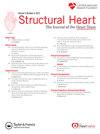Flow Status-Based Predicted Prosthesis-Patient Mismatch in Patients Undergoing Transcatheter Aortic Valve Replacement With a Balloon-Expandable Valve
IF 1.4
Q3 CARDIAC & CARDIOVASCULAR SYSTEMS
引用次数: 0
Abstract
Background
Effective orifice area (EOA) is flow dependent. However, established methods for the assessment of predicted prosthesis-patient mismatch (PPM) do not consider flow status and therefore may underestimate the rate and impact of PPM in patients with abnormal flow status. This study aimed to investigate the clinical impact of flow status-based predicted PPM in patients undergoing transcatheter aortic valve replacement (TAVR).
Methods
Patients undergoing TAVR in a prospective TAVR registry were stratified by the presence of moderate or severe PPM (EOA index to body surface area [EOAi]: 0.65-0.85 or ≤0.65 and 0.55-0.70 or ≤0.55 cm2/m2 if obese). PPM was defined according to echocardiographically measured EOAi (measured PPM) or predicted or flow status-based predicted EOAi. Predicted EOAs were based on reference values of EOA for each valve generation and size (predicted PPMTHV) or native aortic annulus dimension (predicted PPMCT).
Results
Among 1510 patients included (August 2007-June 2022), rates of moderate or severe PPM differed according to method of assessment: 27.0 and 8.7% according to measured PPM, 11.3 and 1.2% according to predicted PPMTHV, 12.0 and 0.1% according to PPMCT, 21.6 and 0.2% according to flow status-based predicted PPMTHV, and 25.1 and 0.4% according to flow status-based predicted PPMCT. Five-year mortality was comparable in patients with and without flow status-based predicted PPM defined by either method. These results were consistent when patients were stratified by flow status.
Conclusions
Rates of PPM differ considerably when flow status is considered. There was no consistent signal of increased risk of adverse events up to 5 years in patients with flow status-based predicted PPM.
Clinical Trial Registration
https://www.clinicaltrials.gov. NCT01368250.
经导管主动脉瓣置换术中基于血流状态预测的假体-患者不匹配
背景有效孔口面积(EOA)与流量有关。然而,现有的评估预测假体-患者失配(PPM)的方法没有考虑血流状态,因此可能低估了血流状态异常患者的PPM率和影响。本研究旨在探讨基于血流状态的预测PPM对经导管主动脉瓣置换术(TAVR)患者的临床影响。方法在前瞻性TAVR登记中,接受TAVR的患者根据是否存在中度或重度PPM (EOA /体表面积指数[EOAi]: 0.65-0.85或≤0.65,肥胖患者为0.55-0.70或≤0.55 cm2/m2)进行分层。PPM是根据超声心动图测量的EOAi(测量的PPM)或预测的或基于血流状态的预测EOAi来定义的。预测EOA是基于每个瓣膜生成和大小(预测PPMTHV)或原生主动脉环尺寸(预测PPMCT)的EOA参考值。结果纳入的1510例患者(2007年8月- 2022年6月)中,不同评估方法的中重度PPM发生率分别为:PPM实测法27.0和8.7%,PPMTHV预测法11.3和1.2%,PPMCT预测法12.0和0.1%,基于血流状态预测PPMTHV预测法21.6和0.2%,基于血流状态预测PPMCT预测法25.1和0.4%。两种方法定义的基于血流状态的预测PPM患者的5年死亡率具有可比性。当患者按血流状态分层时,这些结果是一致的。当考虑流动状态时,PPM的比率差异很大。在基于血流状态预测的PPM患者中,没有一致的信号表明5年内不良事件风险增加。临床试验注册https://www.clinicaltrials.gov。NCT01368250。
本文章由计算机程序翻译,如有差异,请以英文原文为准。
求助全文
约1分钟内获得全文
求助全文
来源期刊

Structural Heart
Medicine-Cardiology and Cardiovascular Medicine
CiteScore
1.60
自引率
0.00%
发文量
81
 求助内容:
求助内容: 应助结果提醒方式:
应助结果提醒方式:


